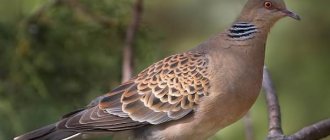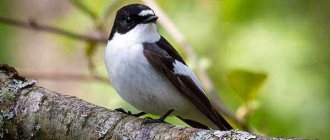Turtle doves, or turtle doves as they are also called, belong to the pigeon family and are common on all continents. The genus includes more than 10 species of birds, some of which live within cities and villages. The following are common in our country:
- ringed,
- short-tailed,
- ordinary,
- big
- small turtle doves.
Some breeders are happy to keep diamond doves at home - small and neat birds with interesting colors.
Emerald doves are also kept at home
Origin of the species and description
Photo: Turtledove
The turtle dove is a genus of birds from the small family of pigeons. Its name is translated from ancient Greek as “dove with a necklace.”
The turtle dove subfamily includes 16 separate species and only 5 of them are found in Russia:
- ringed dove;
- ordinary;
- short-tailed;
- big;
- little dove.
Video: Turtledove
All 16 species form a fairly uniform group of birds with common features. The closest relatives of pigeons and doves were the dodo, which became extinct in the 17th century due to human fault. Over all this time, researchers have discovered very few fossil remains of these birds. There was an opinion that turtle doves, like all pigeons, are related to parrots and hazel grouse. However, later, after a more thorough analysis of the evolutionary chain, researchers agreed that the reason for the external similarity of these birds was convergent evolution, a similar feeding pattern, and not general evolution.
Turtle doves and wild pigeons were domesticated more than 5 thousand years ago. Some varieties were bred only for decorative purposes, while others found practical use. The first mentions of these birds were found in sacred texts when describing the global flood.
Interesting fact: The Laughing Dove is a caged bird and this species is not known in nature.
LIFESTYLE
Previously, the ringed dove lived in the forests of North Africa, Asia Minor and South Asia. Since the beginning of the 20th century, it began to conquer a new habitat, and the birds began to settle in cities. Ringed doves spread throughout Europe. In winter, birds stay in large flocks, preferring areas located near places where grain is stored: farms, mills, zoos, poultry farms. Turtle doves living in Central Europe find food in winter in villages and cities - where people live.
Appearance and features
Photo: What a turtledove looks like
The turtle dove is a bird that is very similar to the common rock pigeon, but more graceful, with a color characteristic of each species. Depending on the variety, the body length of an adult can reach 23-35 centimeters and weight 120-300 grams. The turtledove differs from the pigeon not only in its elegance, but also in its rounded tail and red paws.
The plumage of the upper body of the common dove is colored brown, some feathers have white, beige edges. The bird's neck is decorated with black and white stripes, which look very similar to a necklace. Turtle doves are neopalate birds and their upper jaw can move freely relative to the entire skull. The eye color matches the plumage and can be either black or dark red.
Features of the appearance of some types of doves:
- The great turtle dove is the largest representative of this genus. The average body length of adult individuals is 34-35 cm, and their weight is about 300 grams. It is easy to recognize the Great Dove by its brown upper body and pinkish belly. The black and white necklace is set very far back;
- ringed - this species is distinguished by a longer tail, which can be equal to half the total body length and reach 14-16 cm. The smoky pink color of the head, neck and chest is combined with a gray back. The collared dove's necklace is very colorful;
- diamond - lives only in Australia, and in Russia it is kept exclusively at home. This variety is small in size - about 20 centimeters with a weight of no more than 50 grams. The plumage is ash-blue with a scattering of white spots, and the outer side of the wings is dark gray;
- Sexual dimorphism is not typical for the turtle dove, only sometimes males are larger in size.
Where does the turtledove live?
Photo: Turtle Dove in Russia
Turtle doves are widespread throughout the world. They inhabit all of Eurasia and Africa; some species were brought to Australia and America and successfully took root there. Over the past 100 years, the ringed dove has significantly expanded its habitat and continues to occupy more and more new territories, preferring anthropogenic landscapes.
The habitat of the turtle dove depends on its species: the spotted, ringed, great dove and several other species like to settle in city parks, squares, and in the attics of residential buildings closer to people, but can be found in forests. For the little dove, the city is the only habitat; it is not afraid of people and is very easily tamed.
Emerald, wild laughing dove, African dove live exclusively in deciduous or mixed forests away from populated areas. For these birds, it is very important to have free access to any body of water. Representatives of the northern habitat winter in Africa, mainly in the Sahara and Sudan. Doves living in countries with warm climates do not make annual migrations and lead a sedentary lifestyle.
Interesting fact: Some species of doves living in populated areas often place their nests directly on traffic lights, poles in the middle of busy city streets and are not at all frightened by traffic noise.
Interesting Facts
- This is one of the smallest pigeons, weighing from 100 to 180 g.
- Doves arrive at their breeding grounds in late April and early May, and return to wintering in West Africa at the end of summer and early autumn.
- English turtle doves winter in semi-arid areas of Senegal and Guinea. Birds from Eastern European countries in Sudan and Ethiopia.
- Migratory birds are being targeted by delicacy hunters as they fly through Mediterranean countries. In Malta, the law allows spring hunting of pigeons; in other countries they are hunted predatorily and illegally.
- The turtle dove population has declined by 91% over the past 10 years. The degeneration of the species is associated with problems in wintering and breeding grounds, and not with hunting.
- Seeds are the favorite food of doves. Destroying weeds in agriculture reduces the food supply for pigeons.
- One of the turtle dove’s favorite food plants is fumifera. The plant prefers light, dry soils. Research has shown that weed seeds account for 30-50% of a bird's diet.
- The turtledove's song is soft and soothing. Singing can be heard from the nest all summer.
What does a turtledove eat?
Photo: Dove bird
Among turtle doves there are absolute vegetarians and those who prefer a mixed diet.
The usual diet of these birds may include:
- many types of insects, including parasites dangerous to humans and animals;
- small invertebrates, insect larvae;
- hemp, wheat, buckwheat grains;
- seeds of alder, birch, and other trees and shrubs.
The favorite delicacy of many species of these birds is sunflower. The turtle doves can cause significant damage to crops, completely pecking out the seeds from the baskets of this oilseed crop. Birds collect other grains exclusively from the surface of the ground, without disturbing the plants themselves. Despite the fact that turtle doves can sometimes attack sunflower crops, they are also capable of helping farmers by pecking at weed seeds that “choke” agricultural crops.
When bred in an aviary, the birds are unpretentious in their diet and are not particularly voracious, but they need a fairly large volume of water to drink every day, since without it they are not able to survive even a day.
Interesting fact: Among the Slavic peoples, the appearance of a pair of turtle doves near their home is considered a favorable sign, promising a quick resolution of all existing problems. The first postal birds were also turtle doves, and not an ordinary pigeon.
Features of character and lifestyle
Photo: Common turtledove
These birds of paradise are considered a symbol of love and fidelity for a reason. Having formed a pair, turtle doves remain faithful to their partner throughout their lives. Some species of these birds, after the death of their “spouse,” never unite with other partners and refuse to procreate.
Turtle doves are also constancy in choosing a place to lay eggs. They return to the same nest year after year, provided that predators have not been able to get to it. Both parents hatch the chicks. Migratory species of doves migrate to the African continent in small groups of two dozen individuals at the end of summer or in early September, and return only in May.
Interesting fact: All turtle doves are great talkers. They constantly coo, walk, laugh, make various sounds, but they always do it very loudly. This feature is one of the few disadvantages for keeping them at home.
Doves are very sensitive to stress. If a bird living in an aviary is frightened, it will hit the cage with such force that injuries cannot be avoided. They also should not be allowed out of the cage so that they fly freely around the room, as due to stress they begin to fly at great speed and crash into pieces of furniture and walls. In their natural habitat, birds are calmer.
Social structure and reproduction
Photo: Ringed Dove
In one season, a turtledove can make several clutches of 1-2 eggs, especially those individuals that live in warmer climates. The nesting period for these birds lasts a long time. It often happens that some couples are already incubating eggs, while others are just starting to build a nest. These birds nest on the edges, in forest belts, and parks.
Their flat and not very strong nests are usually located on the branches of trees, among their roots, in bushes, but they can be in completely unexpected places - a lamppost, a fence or a traffic light. To build them, turtle doves use brushwood, grass, and in urban conditions it can even be wire.
Interesting fact: Dove nests are not built every year, preferring to use one for several years in a row. With each year of operation, the nests become stronger, as the droppings of the chicks act like cement.
A married pair of turtle doves incubates a clutch of eggs in turns for 14-16 days. The chicks emerge completely helpless. Parents take care of them for a long time and selflessly protect them, not leaving the nest until the end even in great danger. The young usually begin to fly by the end of the third week of life, then the chicks quickly become independent. They gather in flocks of 8-10 individuals and are ready to reproduce within a year.
Habitat
India is considered the homeland of this small bird, which belongs to the pigeon family. However, already in the 20th century it spread widely throughout central Asia and throughout Europe. As a rule, the common turtledove settles near people. It can often be seen in the vicinity of rock pigeons. Today it inhabits the Nile Delta, Israel and many European countries.
Ornithologists have never been able to agree on the original habitat of this bird. Some are sure that it is a native of Asia Minor, others believe that the homeland of this bird is Sri Lanka or India. Today, the ringed dove lives in Japan, Eastern China, the Arabian Peninsula and South Asia. It is equally common in port docks, village courtyards, zoos, city public gardens, poultry farms and mills. This is one of the few birds that have adapted to living near people.
Natural enemies of the turtle dove
Photo: What an eagle looks like
Under natural conditions, turtle doves live for about 6-7 years and most often die in the claws or jaws of predators.
They have many enemies:
- almost all birds of prey;
- foxes, dogs, cats and other predators that can hunt both adults and young animals and destroy nests.
Some species of doves are subject to hunting. A large number of chicks die in the first week after birth. They often fall out of their nests, and since they cannot fly, they become someone’s prey and their parents cannot help them in any way. It is precisely because of the low survival rate of young animals that many turtle doves carry out not one, but several clutches per season.
Man can also be called the enemy of these birds of paradise. For many decades, some species of doves have been subject to active traditional hunting, especially in their wintering areas, where they arrived in large numbers. Human economic activity also has a negative impact on their population. The fields are treated with various chemicals, and since grain is part of the usual diet of these birds, they are the first to suffer.
Interesting fact: In artificially created conditions, turtle doves can live up to twenty years of age and regularly give birth.
Ringed dove in the Red Book
The bird is listed in the Red Book of the Chuvash Republic as a “Species with uncertain status” according to classification IV. This means that there is insufficient or no information about the number for transfer to another status.
However, ornithologists note a decline in the population in the usual habitat areas of the Republic. The main factors for the decline are considered to be the approach of people to their homes, the destruction of nests by magpies and crows.
In other parts of Russia, no special protective measures have been taken, since the species is not in danger.
Deserves population control as a decoration of gardens and parks. It is protected in European countries.











